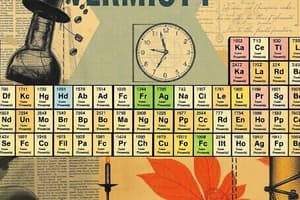Podcast
Questions and Answers
Which process is associated with the addition of an electron to the element B?
Which process is associated with the addition of an electron to the element B?
- Exothermic process (correct)
- Electropositive process
- Ionization process
- Endothermic process
Why does oxygen have a higher electronegativity than sulfur?
Why does oxygen have a higher electronegativity than sulfur?
- Oxygen has a higher electropositivity than sulfur.
- Oxygen has fewer energy levels than sulfur.
- Oxygen has a greater number of protons in its nucleus.
- The bonding electrons in sulfur are closer to the nucleus compared to oxygen. (correct)
What is the primary factor contributing to fluorine being the most electronegative element?
What is the primary factor contributing to fluorine being the most electronegative element?
- Fluorine has a lower electropositivity than other elements.
- The bonding electrons in fluorine are closer to the nucleus compared to other elements. (correct)
- Fluorine has a greater number of energy levels than other elements.
- Fluorine has a greater number of protons in its nucleus.
What trend occurs as the number of electron shells in an element increases?
What trend occurs as the number of electron shells in an element increases?
Why does oxygen have a higher electronegativity than nitrogen?
Why does oxygen have a higher electronegativity than nitrogen?
Which trend correctly describes the change in atomic size in the periodic table?
Which trend correctly describes the change in atomic size in the periodic table?
In which case does ionization energy decrease?
In which case does ionization energy decrease?
What is the definition of electron affinity?
What is the definition of electron affinity?
What is the difference between a stable atom and an unstable atom?
What is the difference between a stable atom and an unstable atom?
What is the trend for ionization energies across a period?
What is the trend for ionization energies across a period?
Study Notes
Electron Affinity and Ionization Energy
- The process associated with the addition of an electron to the element B is electron affinity.
Electronegativity
- Oxygen has a higher electronegativity than sulfur due to its smaller atomic size.
- Fluorine is the most electronegative element primarily because of its very small atomic size.
- Oxygen has a higher electronegativity than nitrogen due to its smaller atomic size.
Atomic Size
- As the number of electron shells in an element increases, the atomic size also increases.
- The trend for atomic size in the periodic table is that it generally decreases from left to right across a period and increases down a group.
Ionization Energy
- Ionization energy decreases when going down a group in the periodic table.
- The trend for ionization energies across a period is that they generally increase from left to right.
Atom Stability
- The definition of electron affinity is the energy change associated with the addition of an electron to a neutral atom.
- A stable atom is one that has a full outer energy level, while an unstable atom is one that does not have a full outer energy level.
Studying That Suits You
Use AI to generate personalized quizzes and flashcards to suit your learning preferences.
Description
Explore the history of the periodic table and learn about the different types of elements along with their important properties. This quiz covers topics such as atomic size and its variations within the periodic table.




